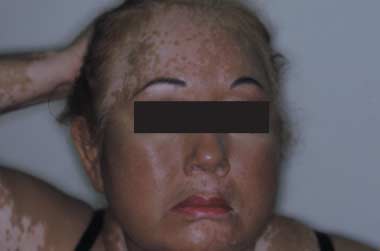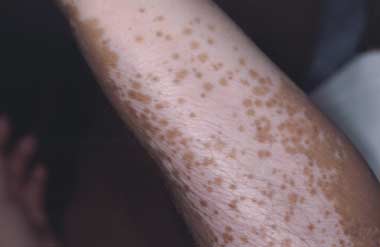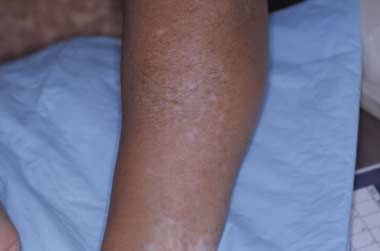Treatment of vitiligo with broadband ultraviolet b and vitamins
Blackwell Publishing, Ltd.International Journal of Dermatology Blackwell Publishing Ltd, 2004 Pharmacology and therapeutics Treatment of vitiligo PHARMACOLOGY and THERAPEUTICS Treatment of vitiligo with broadband ultraviolet B and vitamins
Philip Don, MD, Aurel Iuga, MD, Anne Dacko, MD, and Kathleen Hardick, BA
From the Department of Dermatology, Metropolitan Hospital Campus of New York Background While oral psoralen plus ultraviolet A (PUVA) remains the most popular
Medical College, New York, St. Vincent's therapeutic modality for vitiligo, recent reports have shown that narrowband ultraviolet B (UVB) Catholic Medical Center, New York, and also induces significant repigmentation. In this study we evaluated the efficacy of broadband Memorial Sloan-Kettering Cancer Center, UVB on actively spreading, progressive vitiligo in patients who had been followed for many New York, NY, USA months (12 or more) in our practice, who continued to depigment despite treatment.
Methods Nine patients with actively spreading vitiligo were exposed to broadband UVB 2–3
times per week at a starting dose of 20 –30 mJ /cm2. Radiation was increased by 10 –20 mJ /cm2 Dermatology Associates per session with adjustments for symptomatic erythema or missed visits. In addition, patients 36 Seventh Ave, Suite 423 took vitamin C 500 mg twice a day (BID), vitamin B 1000 µg BID and folic acid 5 mg BID. The response to treatment and side-effects were assessed at each visit. The patient's response to treatment and progress were assessed by photographs and by physician evaluation of body surface area (BSA) (using the Rule of 9s) involved at monthly intervals. Photographs were taken and estimations of BSA by physical examination made at the start and finish of the trial and then compared by the physicians involved in the study.
Results Broadband UVB halted the progression of vitiligo in all nine patients and in general
induced repigmentation early after 8–12 treatments (6 – 8 weeks). After 2– 8 months of treatment, nine of nine patients achieved good (51–75%) or excellent response (76 –100%). The percentage of repigmentation varied with length of treatment and anatomic site.
Conclusions This study confirms the only published report that broadband UVB is effective
on actively spreading vitiligo. Since it is more cost effective than narrowband UVB and has numerous advantages compared to oral PUVA, broadband UVB may offer an alternative for future treatment of vitiligo. The role of vitamins in this therapy remains to be determined.
Materials and Methods
Vitiligo, a hereditary or acquired disease with an incompletely Nine patients (seven women and two men, aged 16 –71 years) of understood pathogenesis, is characterized by amelanotic Hispanic origin (type III–IV skin), four of them with extensive vitiligo macules resulting from a loss of functional skin melanocytes.1,2 (20 – 50%), were included in this prospective study. At the time of Psoralen plus ultraviolet A (PUVA) is the most popular treat- enrollment, the anatomical distribution of the lesions and the ment currently used for vitiligo, but is not always efficient and degree of depigmentation were evaluated clinically and recorded.
is associated with several side-effects. Recent reports have Broadband UVB was delivered by a conventional UVB box, 2– 3 shown that narrowband (311 nm) ultraviolet B (UVB) can times per week at a starting dose of 20 – 30 mJ / cm2. Radiation was induce significant repigmentation in either generalized3,4 or increased by 10 –20 mJ / cm2 per session with adjustments for segmental5 vitiligo. In comparing the treatment of vitiligo symptomatic erythema and missed visits. Patients applied mineral with 311-nm UVB radiation versus topical PUVA, Westerhof 3 oil prior to UVB therapy.
concluded that UVB therapy was slightly more effective, pro- The patients also received oral vitamin supplementation, which duced faster repigmentation and had fewer side-effects. How- included vitamin C 500 mg twice a day (BID), vitamin B 1000 µg ever, narrowband UVB therapy is not readily available and BID and folic acid 5 mg BID. The response to treatment and implies significant start-up expenses. In 1990, Koster and side-effects were assessed at each visit. Treatment results were Wiskemann6 suggested in the only known published report recorded for each anatomic area and estimated by classifying the that broadband UVB could also be effective in treating vitiligo.
degree of repigmentation into five groups: 0%, no repigmentation; Consequently, we evaluated the efficacy of broadband UVB 0 –25%, poor repigmentation; 26 –50%, moderate repigmentation; on actively spreading vitiligo.
51–75%, good repigmentation; 76 –100%, excellent repigmentation.
2005 The International Society of Dermatology International Journal of Dermatology 2006, 45, 6 3 –65



Pharmacology and therapeutics
Treatment of vitiligo
Don et al.
depression. Although there are many therapeutic alternatives
validated by clinical studies, such as PUVA, corticosteroids,
Broadband UVB halted the progression of vitiligo in all nine
or surgical techniques, the search for a more effective treat-
patients and in general induced repigmentation after 8–12
ment continues.
treatments (6 – 8 weeks) ( Table 1). After 2–10 months oftreatment, all nine patients experienced significant repigmen-tation: 51–75% in some areas and 76 –100% in other areas( Figs 1–3). Similar to other therapeutic modalities, broad-band UVB induced follicular, marginal, and homogeneousforms of repigmentation. Maximal responses were obtainedon the trunk, and on the proximal and distal extremities, andintermediate responses were obtained on the face, neck, hands,and feet. The side-effects were minimal and included milderythema, mild pruritis, reactivation of Herpes Simplex Virus(HSV), and folliculitis (mineral oil induced).
Vitiligo is a common disease that affects 0.5–2% of the popu-lation, causing emotional distress, social isolation, and even
Figure 2 Repigmentation on the arm of patient 1
Figure 1 Repigmentation on the face of patient 1
Figure 3 Repigmentation on the arm of patient 3
Table 1 Broadband UVB treatment for vitiligo, with raw data for nine patients
Duration
Hands /feet
BSA, body surface area; NI, not involved.
International Journal of Dermatology 2006, 45, 6 3 –65
2005 The International Society of Dermatology
Don et al.
Treatment of vitiligo
Pharmacology and therapeutics
Similar to PUVA treatment, the underlying mechanism of
out success. Until more extensive studies have confirmed our
repigmentation following UVB exposure is probably related
results, we will confine our conclusions to stating that broad-
both to an inhibitory effect on cytotoxic T lymphocytes and
band UVB is not only readily available, but also at least as
to a release of cytokines involved in melanocyte migration
effective in treating vitiligo as 311-nm UVB in this small study.
and proliferation.7 The effect of UVA and UVB stimulationand migration of melanocytes from follicules also contributesto repigmentation.2,4
Broadband UVB, however, has numerous advantages com-
1 Lepoole IC, Van Den Wijngaard R, Westerhof W, et al.
pared to PUVA and may offer an alternative for patients who
Presence or absence of melanocytes in vitiligo lesions: an
cannot tolerate or who have failed treatment with PUVA.
immunohistochemical investigation. J Inv Dermatol 1993;
Broadband UVB has fewer side-effects (no photoallergic or
100: 816 – 822.
phototoxic reactions were seen) and the use of psoralen is no
2 Grimes PE. Vitiligo: an overview of therapeutic approaches.
longer required. Broadband UVB induced repigmentation
Dermatol Clin 1993; 11: 325 –338.
after 8 –12 treatments (6 – 8 weeks). In a previous report,3
3 Westerhof W, Nieuweboer-Krobotova L. Treatment of
narrowband UVB had the same effect after 6 weeks (12
vitiligo with UVB radiation versus topical psoralen plus
UVA. Arch Dermatol 1997; 133: 1525 –1528.
The decision to supplement the patients with high-dose
4 Njoo MD, Bos JD, Westerhof W. Treatment of generalized
vitamins was based on the previous successful experiences of
vitiligo in children with narrowband (TL-01) UVB radiation
therapy. J Am Acad Dermatol 2000; 42: 245 –253.
associating adjunctive therapies with short-term UVB8 and on
5 Lotti TM, Menchini G, Andreassi L. UV-B radiation
a number of studies9,10 that showed improvement of vitiligo
microphototherapy: an elective treatment for segmental
when treated with vitamin supplementation, especially in
vitiligo. J Eur Acad Dermatol Venereol 1999; 13: 102–108.
sun-exposed areas. The exact role of vitamins has yet to be
6 Koster W, Wiskemann A. Phototherapy with UVB in
elucidated. It is not known whether vitiligo patients lack suf-
vitiligo. J Hautkr 1990; 65: 1022–1024.
ficient vitamin levels or whether the higher dose of vitamins
7 Fitzpatrick TB. Mechanisms of phototherapy of vitiligo.
somehow acts to stimulate repigmentation.
Arch Dermatol 1999; 133: 1591–1592.
The possibility of vitamin deficiency has been debated in
8 Schallreuter KU, Wood JM, Lemke KR, et al. Treatment of
previous research.9,10 In our study, vitamin levels prior to treat-
vitiligo with a topical application of pseudocatalase and
ment were not assessed. Patient 9, who was breast-feeding,
calcium in combination with short-term UVB exposure: a
did not take the high-dose vitamins during 4 months of
case study on 33 patients. Dermatology 1995; 190: 223 –
229.
therapy and had minimal repigmentation but no progression
9 Juhlin L, Olsson MJ. Improvement of vitiligo after oral
of vitiligo. When she stopped breast-feeding she began vitamin
treatment with vitamin B and folic acid and the importance
therapy, and, after 8 weeks on UVB therapy and vitamins, she
of sun exposure. Acta Dermatol Venereol 1997; 77: 460 –
began showing significant repigmentation. Other studies using
either narrowband or broadband UVB for repigmentation
10 Montes LF, Diaz ML, Lajous J, et al. Folic acid and vitamin
did not use vitamin supplementation and still reported repig-
B in vitiligo: a nutritional approach. Cutis 1992; 50: 39 –
mentation.3,4 Our patients were all skin types III–IV as were
patients treated in previous reports who improved with UVB.
11 Srinivas CR, Shenoi SD, Balachandran C. Acceleration of
Patients with these skin types may have better responses using
repigmentation in vitiligo by topical minoxidil in patients on
this therapy, as has been found with PUVA therapy.2
photochemotherapy. Int J Dermatol 1990; 25: 154 –155.
Patients tended to plateau in improvement after 8 –10 months,
12 Sahin S, Hindioglu U, Karaduman A. PUVA treatment of
vitiligo. a retrospective study of Turkish patients. Int J
then repigmentation occurred slowly, in minute increments.
Dermatol 1999; 38: 542–545.
After peak repigmentation, UVB therapy continued with
13 Kim SM, Lee HS, Hann SK. The efficacy of low dose oral
additional topical modalities,2,11–13 which have been anecdot-
corticosteroids in the treatment of vitiligo patients. Int J
ally reported to improve repigmentation, including copper
Dermatol 1999; 38: 546 –550.
cream, vitamin C cream, 5% minoxidil solution, high-potency
14 Kim SM, Kim YK, Hann SK. Serum levels of folic acid and
steroids, dovonex, tretinoin cream, glycolic acid peels,
vitamin B in Korean patients with vitiligo. Yonsei Med J
trichloroacetic acid (TCA) peels, tar therapy and UVA, with-
1999; 40: 195–198.
2005 The International Society of Dermatology
International Journal of Dermatology 2006, 45, 6 3 –65
Source: http://projeuni.ir/wp-content/uploads/2013/12/3965__ascb+adjknjk.pdf
heb.org.sg
A PUBLICATION OF THE HINDU ENDOWMENTS BOARD, SINGAPORE We wish all our devotees and well-wishers A Very Happy New Year and Happy Pongal. ,dpa 2016 Gj;jhz;L tho;j;Jf;fs; kw;Wk; MovinG Forward in 2016 new initiativeS For thaipuSaM what'S on I hope all of you had a great holiday season. I am sure that, many positive things will happen
Data di stampa
Technical Date of issue: 14 November 2008 CIVITANOVA MARCHE(MC) - ITALY - brand: MARMOLIT A. DESCRIPTION OF THE PREPARATION The solid cream glue is a compound made of unsaturated polyester modified resin, dissolved in monomer styrene, to which is added an unsaturated polyester ortophtalic modified resin, condensed with standard glycol and pre-accelerated with hardener.The preparation has good characteristics of chemical mechanical resistance, brightness and stability after hardening.